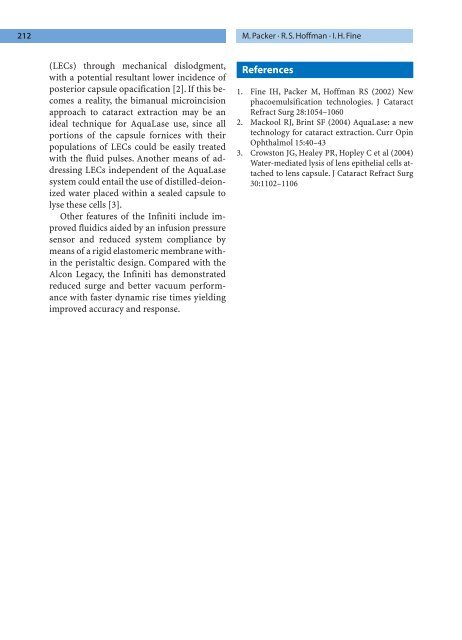- Page 2 and 3:
Refractive Lens Surgery I. H. Fine
- Page 4 and 5:
Editors I. Howard Fine, MD Mark Pac
- Page 6 and 7:
Preface The first recorded time a h
- Page 8 and 9:
X Contents Chapter 14 AcrySof ReSTO
- Page 10 and 11:
Contributors Jorge L. Alio, MD, PhD
- Page 12 and 13:
1 The Crystalline Lens as a Target
- Page 14 and 15:
2 CORE MESSAGES Refractive Lens Exc
- Page 16 and 17:
na that have been observed with som
- Page 18 and 19:
piration through two separate incis
- Page 20 and 21:
6 R.S. Hoffman · I.H. Fine · M. P
- Page 22 and 23:
8 R.S. Hoffman · I.H. Fine · M. P
- Page 24 and 25:
10 R.S. Hoffman · I.H. Fine · M.
- Page 26 and 27:
12 M. Packer · I.H. Fine · R.S. H
- Page 28 and 29:
14 M. Packer · I.H. Fine · R.S. H
- Page 30 and 31:
16 M. Packer · I.H. Fine · R.S. H
- Page 32 and 33:
18 M. Packer · I.H. Fine · R.S. H
- Page 34 and 35:
20 M. Packer · I.H. Fine · R.S. H
- Page 36 and 37:
22 J.T. Holladay 4.1 Introduction T
- Page 38 and 39:
24 J.T. Holladay but only seven pre
- Page 40 and 41:
26 J.T. Holladay from morning to ni
- Page 42 and 43:
28 J.T. Holladay 4.3.2.2.3 Corneal
- Page 44 and 45:
30 J.T. Holladay rienced this condi
- Page 46 and 47:
32 J.T. Holladay many of these pati
- Page 48 and 49:
34 J.T. Holladay IOL eRx V 1336 =
- Page 50 and 51:
36 J.T. Holladay raised. A more tho
- Page 52 and 53:
38 J.T. Holladay rior segment laser
- Page 54 and 55:
40 D.D. Koch · L.Wang corneal refr
- Page 56 and 57:
42 D.D. Koch · L.Wang Table 5.1. M
- Page 58 and 59:
44 D.D. Koch · L.Wang Fig. 5.4. Nu
- Page 60 and 61:
46 D.D. Koch · L.Wang Fig. 5.5. Ce
- Page 62 and 63:
48 D.D. Koch · L.Wang ∑ Double-K
- Page 64 and 65:
50 L.D. Nichamin surgeon the abilit
- Page 66 and 67:
52 L.D. Nichamin Table 6.1. The Nic
- Page 68 and 69:
54 L.D. Nichamin 3.2 mm, its neglig
- Page 70 and 71:
56 L.D. Nichamin Fig. 6.4. The Nich
- Page 72 and 73:
58 L.D. Nichamin References 1. Anon
- Page 74 and 75:
60 S. Bylsma aphakic state. In cont
- Page 76 and 77:
62 S. Bylsma length),underwent full
- Page 78 and 79:
64 S. Bylsma K-Astigmatism
- Page 80 and 81:
66 S. Bylsma STIOL in the reversed
- Page 82 and 83:
68 S. Bylsma about the dynamics at
- Page 84 and 85:
8 Correction of Keratometric Astigm
- Page 86 and 87:
Fig. 8.2. AcrySof toric IOL implant
- Page 88 and 89:
Fig. 8.3. Mean absolute residual cy
- Page 90 and 91:
References 1. Hoffer KJ (1980) Biom
- Page 92 and 93:
80 M. Packer · I.H. Fine · R.S. H
- Page 94 and 95:
82 M. Packer · I.H. Fine · R.S. H
- Page 96 and 97:
84 M. Packer · I.H. Fine · R.S. H
- Page 98 and 99:
10 The Eyeonics Crystalens Steven J
- Page 100 and 101:
Fig. 10.3. Under binocular conditio
- Page 102 and 103:
Fig. 10.6. Anterior movement of the
- Page 104 and 105:
Fig. 10.7. One- and 3-year data fro
- Page 106 and 107:
10.6 Postoperative Considerations C
- Page 108 and 109:
10. Dell SJ (2004) Objective eviden
- Page 110 and 111:
100 N.X. Nguyen · A. Langenbucher
- Page 112 and 113:
102 N.X. Nguyen · A. Langenbucher
- Page 114 and 115:
104 N.X. Nguyen · A. Langenbucher
- Page 116 and 117:
106 N.X. Nguyen · A. Langenbucher
- Page 118 and 119:
108 N.X. Nguyen · A. Langenbucher
- Page 120 and 121:
110 N.X. Nguyen · A. Langenbucher
- Page 122 and 123:
12 CORE MESSAGES Synchrony IOL H. B
- Page 124 and 125:
Fig. 12.1. The single-piece silicon
- Page 126 and 127:
12.5 Clinical Results Clinical tria
- Page 128 and 129:
Fig. 12.6. Retroillumination photog
- Page 130 and 131:
References 1. Fisher RF (1973) Pres
- Page 132 and 133:
124 F.M. Sarfarazi 13.1 The Nature
- Page 134 and 135:
126 F.M. Sarfarazi Fig. 13.4. Lens
- Page 136 and 137:
128 F.M. Sarfarazi Fig. 13.5. Mecha
- Page 138 and 139:
130 F.M. Sarfarazi Fig. 13.9. Secon
- Page 140 and 141:
132 F.M. Sarfarazi Fig. 13.14. Sche
- Page 142 and 143:
134 F.M. Sarfarazi Fig. 13.18. Work
- Page 144 and 145:
136 F.M. Sarfarazi References 1. Ma
- Page 146 and 147:
138 A. Mirshahi · E.Terzi · T. Ko
- Page 148 and 149:
140 A. Mirshahi · E.Terzi · T. Ko
- Page 150 and 151:
142 A. Mirshahi · E.Terzi · T. Ko
- Page 152 and 153:
15 The Tecnis Multifocal IOL Mark P
- Page 154 and 155:
Fig. 15.1. The Alcon AcrySof multif
- Page 156 and 157:
Fig. 15.4. Multifocal vs. monofocal
- Page 158 and 159:
16 Blue-Light-Filtering Intraocular
- Page 160 and 161:
Fig. 16.2. Cultured human RPE cells
- Page 162 and 163:
tion to benefiting from less exposu
- Page 164 and 165: 16.7 Blue-Light-Filtering IOLs and
- Page 166 and 167: 15. Marshall J, Mellerio J, Palmer
- Page 168 and 169: 17 CORE MESSAGES The Light-Adjustab
- Page 170 and 171: Fig. 17.2 a-c. Cross-sectional sche
- Page 172 and 173: 17.4 Animal Studies Dr. Nick Mamali
- Page 174 and 175: Fig. 17.8. A laser interferogram (l
- Page 176 and 177: enhanced visual function that remai
- Page 178 and 179: 13. Mather R, Karenchak LM, Romanow
- Page 180 and 181: 174 S. Norrby Fig. 18.1. Small cale
- Page 182 and 183: 176 S. Norrby Fig. 18.3. Scheimpflu
- Page 184 and 185: 178 S. Norrby Fig. 18.4. Schematic
- Page 186 and 187: 180 S. Norrby there was fibrin form
- Page 188 and 189: 182 S. Norrby material had a Young
- Page 190 and 191: 184 S. Norrby Koopmans et al. [28]
- Page 192 and 193: 186 S. Norrby 40. De Groot JH, Zuru
- Page 194 and 195: 188 L. Nordan · M. Morris regular
- Page 196 and 197: 190 L. Nordan · M. Morris produce
- Page 198 and 199: 20 CORE MESSAGES Bimanual Ultrasoun
- Page 200 and 201: for an irrigating manipulator or ch
- Page 202 and 203: 5. Tsuneoka H, Shiba T, Takahashi Y
- Page 204 and 205: 200 J.L. Alio · A. Galal · J.-L.R
- Page 206 and 207: 202 J.L. Alio · A. Galal · J.-L.R
- Page 208 and 209: 204 J.L. Alio · A. Galal · J.-L.R
- Page 210 and 211: 206 J.L. Alio · A. Galal · J.-L.R
- Page 212 and 213: 22 CORE MESSAGES The Infiniti Visio
- Page 216 and 217: 23 CORE MESSAGES The Millennium Ros
- Page 218 and 219: Fig. 23.1. Bausch & Lomb’s new cu
- Page 220 and 221: Fig. 23.2. Advanced flow system car
- Page 222 and 223: Fig. 23.5. Pulse or burst mode with
- Page 224 and 225: 24 CORE MESSAGES The Staar Sonic Wa
- Page 226 and 227: Fig. 24.2. The tip undergoes compre
- Page 228 and 229: the sonic tip moves back and forth
- Page 230 and 231: 25 CORE MESSAGES AMO Sovereign with
- Page 232 and 233: Fig. 25.3. Schematic diagram of cav
- Page 234 and 235: the Sovereign Compact (see Fig. 25.
- Page 236 and 237: 234 M. Packer · R.S. Hoffman · I.
- Page 238 and 239: 27 Conclusion: The Future of Refrac
- Page 240 and 241: 240 Subject Index Contrast sensitiv
- Page 242 and 243: 242 Subject Index P Pachymetry 53,



